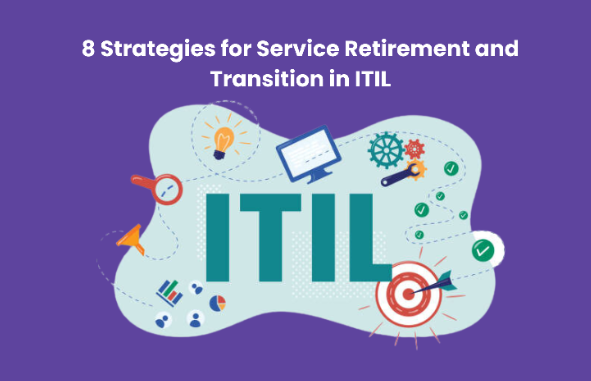
8 Strategies for Service Retirement and Transition in ITIL
Within the ITIL service lifecycle, transition and service retirement are two crucial stages that need considerable thought and strategic preparation. The Information Technology Infrastructure Library, or ITIL, is a framework that is well-known for its top IT service management techniques. This framework is intended to help businesses optimise their IT operations and provide top-notch services. With the growing popularity of ITIL Courses, it’s critical to comprehend how to move smoothly through the ITIL Service Lifecycle and negotiate the challenges of service retirement.
In this blog, we provide helpful insights to efficiently traverse these crucial procedures as we examine eight key options for service retirement and transition within the ITIL service lifecycle.
Table of Contents
- The Importance of ITIL Service Retirement and Transition
- Strategy 1: Defining a Clear Service Retirement Policy
- Strategy 2: Comprehensive Stakeholder Communication
- Strategy 3: Evaluation of Service Impact
- Strategy 4: A Phased Transition Approach
- Strategy 5: Documentation and Knowledge Transfer
- Strategy 6: Post-Transition Evaluation
- Strategy 7: Change Management Best Practices
- Strategy 8: Service Portfolio Optimization
- Conclusion
The Importance of ITIL Service Retirement and Transition
The ITIL service lifecycle includes phases for service evaluation, modification, and retirement in response to changing business requirements, technical developments, and other organisational considerations. These stages guarantee that IT services continue to be in line with the aims and objectives of the company. As the ITIL framework becomes more widely known, thanks to ITIL courses, companies are realising how important it is to improve and modify their service management procedures.
Strategy 1: Defining a Clear Service Retirement Policy
Creating a clearly defined service retirement policy is the first step in the process of thinking through service retirement and transition. Understanding which services should be terminated and why is critical, as shown by an ITIL service lifecycle strategy. Through ITIL courses, organisations may discover how to identify obsolete or duplicate services and save time and money by implementing a consistent strategy.
Strategy 2: Comprehensive Stakeholder Communication
Any service transfer strategy must include efficient communication with all parties. ITIL courses place a strong emphasis on this lecture. Businesses must make sure that all stakeholders, including employees, clients, and outside suppliers, are clearly informed of the decision to discontinue or transfer a service. This helps to smooth the changeover process overall and regulates expectations.
Strategy 3: Evaluation of Service Impact
It is impossible to exaggerate the significance of retiring or changing a service. The need to evaluate how these changes would impact the company is mandated by the ITIL service lifecycle principles. Determining the possible dangers, opportunities, and outcomes requires thorough study. This strategy, promoted in ITIL courses, gives firms the information needed for wise decision-making.
Strategy 4: A Phased Transition Approach
Transitioning services need to be a systematic, phased-in process rather than a sudden change. Organisations are encouraged to use a phased transition strategy by the ITIL service lifecycle. With this approach, modifications can be made more quickly, interruptions can be kept to a minimum, and new procedures may be tested and validated before being fully implemented.
Strategy 5: Documentation and Knowledge Transfer
A successful service move in the context of the ITIL service lifecycle depends on keeping correct documentation. All pertinent data, protocols, and settings pertaining to the retiring or transitioning service must be documented by organisations. The importance of this information transfer is emphasised in ITIL courses, guaranteeing that modifications in the future are well-informed and steer clear of previous errors.
Strategy 6: Post-Transition Evaluation
Even after a service is discontinued or transitioned, the journey continues. An assessment should be conducted after the change as well. This includes determining if the move achieved its goals, reviewing customer input, and resolving any unanticipated problems. Such assessments highlight the ongoing improvement component of service management, which is emphasised in ITIL service lifecycle training.
Strategy 7: Change Management Best Practices
An essential component of a successful service retirement and transition is change management. Organisations must act fast to adapt to the ever-changing IT world, where advancements in technology are transforming how businesses operate on a daily basis. Implementing the best practices for change management that are covered in ITIL courses ensures that service transitions go smoothly and without major setbacks.
Planning ahead, communicating clearly, and assessing risks are all part of change management. It enables businesses to foresee problems and take preventative action to alleviate them. Businesses may make the required changes while preserving operational stability by including change management in the service transition process.
Strategy 8: Service Portfolio Optimisation
Service portfolio optimisation aligns services with strategic objectives. According to ITIL, companies should evaluate their service portfolios and identify opportunities for improvement. ITIL training may help organisations evaluate service performance, costs, and customer satisfaction before retiring or transitioning services.
By increasing their service portfolio, organisations may ensure their offerings are appreciated and relevant. This lowers duplication and promotes service quality improvement.
Conclusion
Retirement and transition are essential ITIL service lifecycle processes that impact an organisation’s IT Service Management. As they invest more in ITIL courses to enhance service management, businesses must prepare for service retirement and transition.
By taking the eight steps before, organisations may improve service transfer efficiency and reduce disruption. IT service management works best when planning, communicating, reviewing, and post-transition evaluating IT services against organisational needs.
To know more about keep reading bloggers wheel



